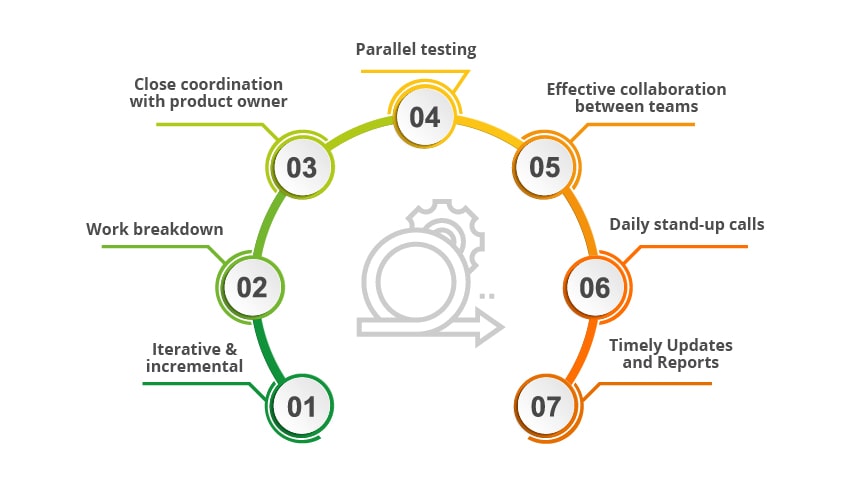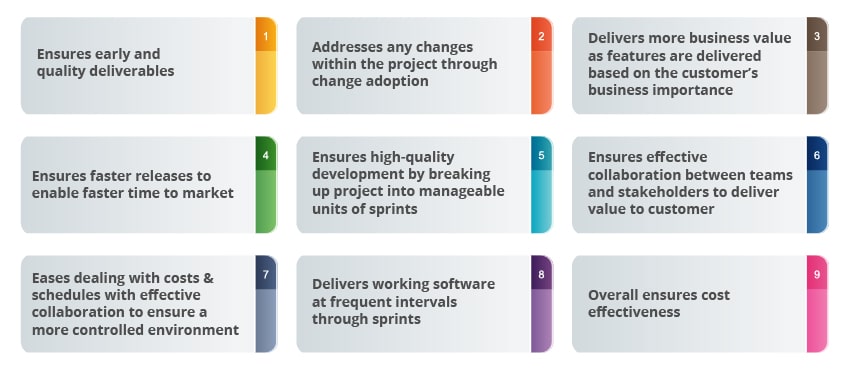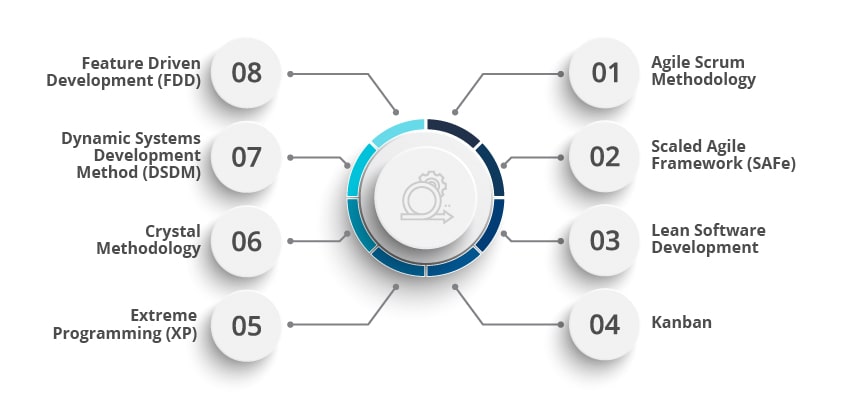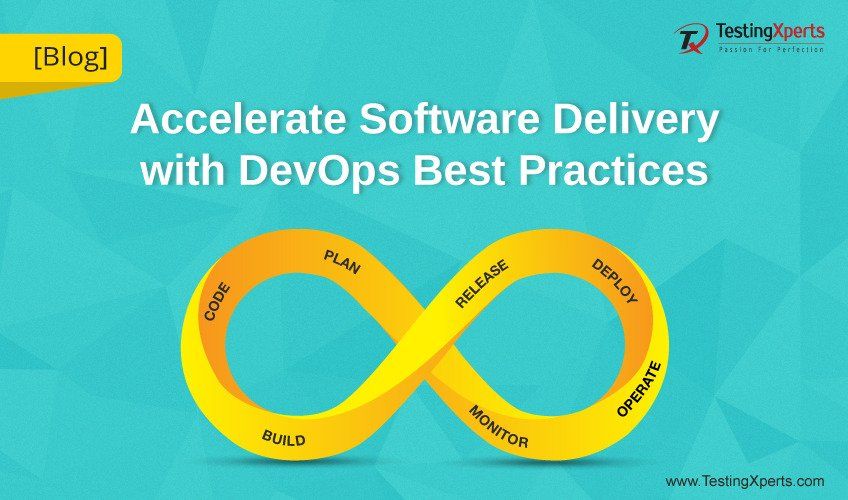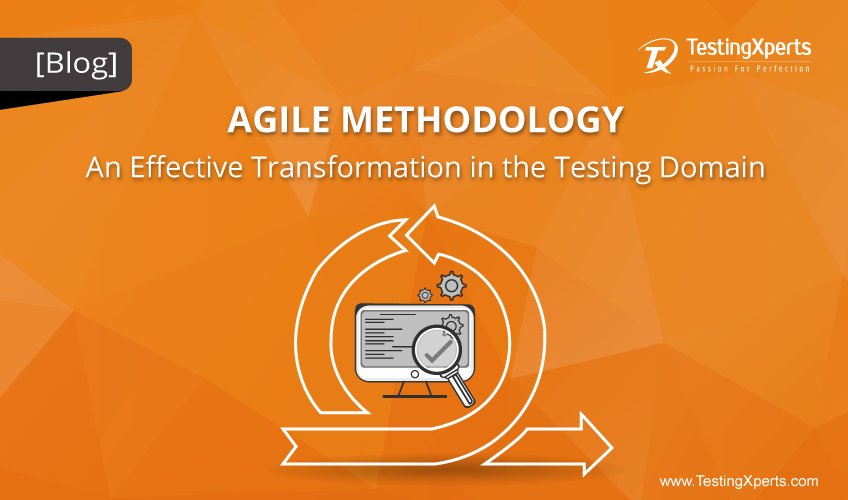
Content
- What is Agile Methodology
- Agile Development Methodology Features
- What are the principles of Agile Methodology
- Agile Manifesto Principles
- Benefits of Agile Methodology
- Significance of Agile Methodology for Businesses
- Types of Agile Methodologies and Frameworks
- Conclusion
What is Agile Methodology
Agile methodology is the most significant approach to project management which is effectively used in the process of software development. This agile approach has been majorly introduced in the field of software development to overcome difficulties with earlier waterfall model and to make processes more flexible and effective.
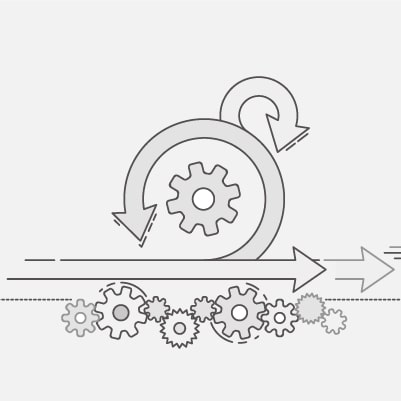
Specifically, the agile methodology definition refers to the software development process centered around the idea of iterative development. In this agile development methodology, requirements and solutions evolve through proper collaboration between cross-functional teams and the product owner. This unique software development process ensures teams to deliver value faster with quality and predictability and handles changes effectively.
Agile Development Methodology Features
Iterative & incremental:
This agile methodology feature proposes incremental and iterative approach with frequent reassessments to make the product better.
Work breakdown:
The agile process consists of small cycles technically known as sprints or scrum. It involves breaking down the project work into iterations or sprints
Close coordination with product owner:
The product owner or customer has a first-hand overview of every stage of project development along with changes if any.
Parallel testing:
The software development and the software testing are taken up in parallel to ensure quality software is delivered. Regression testing is involved every time whenever new functions or logic is added
Effective collaboration between teams:
Testers and developers work in close collaboration when compared to the earlier waterfall model
Daily stand-up calls:
Every day scheduling of short and quick meetings as stand up calls is taken up to review the tasks status within the agile process
Timely Updates and Reports:
The agile methodology process places upfront the product owner to be updated with daily, and weekly reports on project status which makes the process transparent
The agile development methodology emphasizes and practices four basic principles of agile manifesto which have been given below:
What are the principles of Agile Methodology?
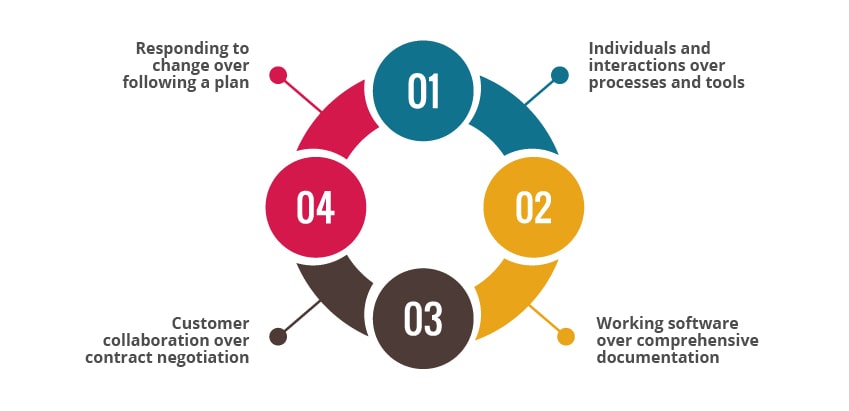
1. Individuals and interactions over processes and tools
2. Working software over comprehensive documentation
3. Customer collaboration over contract negotiation
4. Responding to change over following a plan
Evidently, the agile methodology steps and the process revolves around iterations as priorities can be shifted from iteration to iteration and new features tend to be added into the next iteration. Basically any agile manifesto is followed by some important agile principles which businesses should essentially know and adapt in their agile software development process.
Life Cycle of Agile Methodology
The lifecycle of agile involves a series of phases that a product has to go through. It starts with the concept stage and goes all the way to the retirement stage. Let’s take a quick look at the Agile SDLC phases:
- Concept: The agile teams plan the project’s vision, scope, goals, and objectives.
- Inception: This phase focuses on completing a small amount of work to enable teams to follow the project’s direction.
- Iteration: In this phase, the teams integrate enough functionality to present to stakeholders, satisfy their current goals, and configure it for package implementation.
- Release: This phase involves performance testing, security assessments, documentation, and user acceptance testing. The primary goal is to satisfy user demands and ensure the product’s success. After the final development, it is released into the production stage.
- Production: This phase ensures the product is viable and running when deployed to the end-users.
Agile Manifesto Principles Businesses Must Know
1. Customer satisfaction through faster and continuous software delivery
Agile focuses on minimizing the time between ideations and launch. The goal is to provide a working product to customers in the shortest amount of time. Moreover, customers can be satisfied by following frequent iteration process along with aligning with the market requirements on a continual basis.
2. Accommodate changing requirements throughout the development process
Agile encourages changes that might take place during the development process. In Agile methods, the changing trends are observed, customer needs and behaviour are studied in-depth, and accordingly change requests are worked upon in the agile software development process.
3. Frequent delivery of working software
Agile methods believes in dividing a product into smaller components and then deliver those components frequently in the form of sprints. Through this methodology, these frequent mini-releases of the product that are built will actually boost the product’s overall development.
4. Collaboration between business stakeholders & developers throughout the project
A proper communication channel works wonders for any software project. It’s the teamwork in the agile model that dominates and hence there must be a proper communication channel set-up between the business stakeholders and the technical team.
Typically, a product achieves success only if it is able to be viewed both from a business and technical standpoint. Hence, the business team and the technical team must work collaboratively.
5. Support, trust, and motivate the people involved
Team motivation plays an important role such that the efficiency and outcome of the project are up to the mark. The agile teams involved should have good hands-on experience to ensure project success.
6. Enable face-to-face interactions
One of the other agile principles revolves around the ease with which various teams can work in close collaboration using various video conferencing and other modes of interactions.
7. Working software is the primary measure of progress
From an agile methodology perspective, customers will respond to working software in a much better manner than a final product that is all perfect.
8. Attention to technical detail and design enhances agility
Despite the fact that agile methodology favours frequent releases and changes in requirements, there must be a stringent protocol set in place for carrying out agile activities, which brings orderliness to the work. This will only make the future less troublesome.
9. Simplicity
This agile principle focuses on churning out work from especially those areas where the outcome is up to the mark and satisfactory. This means that the team members must have a clear understanding of the project objectives and what is expected exactly out of them.
10. Self-organizing teams encourage great architectures, requirements, and designs
Agile methods encourages teams to make critical business decisions rather than depending upon a senior manager. The teams must work in such a manner that they are able to define the processes involved in the project at all levels so that the team members have an idea as to what the outcome can be.
11. Regular reflections on how to become more effective
The final agile principle states that teams must have a learning attitude so that they can learn certain processes they are not familiar with. Also, the teams must learn about the changing customer requirements and the trends going on in the marketplace, so that the concerned teams can adopt and implement best practices.
Difference Between Agile v/s Waterfall Methodology
| Aspect | Agile Methodology | Waterfall Methodology |
| Approach | Iterative and incremental | Sequential and linear |
| Flexibility | Highly flexible, allows changes anytime | Rigid and challenging to modify once a phase is completed |
| Project Phases | Development, testing, and feedback occur simultaneously | Each phase (requirements, design, development, testing, and deployment) is completed before moving to the next |
| Delivery Speed | Faster delivery in small increments (sprints) | Delivered as a whole after the project completion |
| Customer Involvement | Continuous customer feedback and collaboration | Limited customer involvement after the initial requirements phase |
| Testing Process | Testing happens alongside development in every sprint | Testing is done after development, increasing the risk of late defect detection |
| Risk Management | Early risk detection due to iterative cycles | Risks are identified late, making resolution costlier |
| Documentation | Minimal documentation, focusing on working software | Extensive documentation is required at every phase |
Limitations of Agile Development Methodologies:
While being flexible and adaptable, Agile development methodology has some limitations, such as:
- Scope Creep: The iterative nature of Agile software methodology gives rise to scope creep if project requirements are not defined and managed clearly. This will lead to missed deadlines and feature creep.
- Difficult to Scale: Although best for smaller teams, scaling Agile development in software engineering for larger and more complex projects can lead to coordination issues.
- Inconsistent Results: Frequent changes in the project development can lead to inconsistent results, showing a lack of clear leadership or vision.
- Limited Predictability: Agile’s flexibility makes it difficult to predict delivery timelines and costs upfront, which is challenging for stakeholders.
Benefits of Agile Methodology
– Ensures early and quality deliverables
– Addresses any changes within the project through change adoption
– Delivers more business value as features are delivered based on the customer’s business importance
– Ensures faster releases to enable faster time to market
– Ensures high-quality development by breaking up project into manageable units of sprints
– Ensures effective collaboration between teams and stakeholders to deliver value to customer
– Eases dealing with costs & schedules with effective collaboration to ensure a more controlled environment
– Delivers working software at frequent intervals through sprints
– Overall ensures cost effectiveness
Significance of Agile Methodology for Businesses

Delivers real-business value:
This agile process focusses on driving real-business value to customers. This methodology places more value on outcomes by enabling quality products that meet the customer’s business goals. This agile methodology approach ensures effective collaboration between teams and stakeholders to achieve a complete understanding of the stakeholder’s business goals.
Close involvement of stakeholders in agile process:
Agile development methodology helps stakeholders to be involved throughout the project and helps to get an effective working model of the software. The process of software development is faster as bugs are identified early with parallel software testing process taken up along with development.
Ensures visual project management:
Businesses get a visual project management as agile teams enhance their ability to work collaboratively by presenting the data in a visual form. This eases businesses to comprehend project details and to manage change.
Scalability:
Businesses determine the scalability of a project based on the time and cost factors. Essentially the key advantage of agile methodology is that it is an effective and scalable project management tool.
Teams collaboration:
Specifically, for businesses, the ability of teams to adapt to change is a cornerstone of agile project management and is an important advantage of agile methodology in testing. Moreover, when agile teams put their time to good use, they deliver what the stakeholder wants without excess spending due to careful usage of teams’ skills and expertise. This sort of effective team usage and active collaboration between teams ensures there will be no overspending involved in the project.
Types of Agile Methodologies and Frameworks
1. Agile Scrum Methodology
2. Scaled Agile Framework (SAFe)
3. Lean Software Development
4. Kanban
5. Extreme Programming (XP)
6. Crystal Methodology
7. Dynamic Systems Development Method (DSDM)
8. Feature Driven Development (FDD)
1. Agile Scrum methodology:
This type of agile methodology is one of the most dominant agile methodology followed by enterprises. It is exclusively used by 58% of organizations and another 18% use it combined with other agile methods. This is a light-weight agile project management framework that is effectively used for controlling and managing iterative and incremental projects.
The scrum consists of various roles and responsibilities that are given below:
– A Scrum Master is responsible for the team overview, for planning of sprint meetings and also ensures proper collaboration between teams
– There is a Product Owner who is responsible for product backlog creation and for delivery of the functionalities. The Product Backlog consists of features, bug fixes, other non-functional requirements, etc.
– The Scrum team manages the work and is responsible to develop features and deliver them for each sprint cycle
– Each iteration of scrum is called sprint and teams work on defined sprint backlog
– Daily scrum meetings are conducted to evaluate the progress of the scrum teams
– At the end of each sprint, team delivers functionalities developed and tested during that period to the product owner
This is the most commonly used agile methodology and is suitable for all types of projects.
2. Scaled Agile Methodology (SAFe):
This is a leading framework for scaling Agile across the enterprise. This methodology is used by world’s largest organizations to achieve the benefits of lean agile software and ensures systems development at scale. This SAFe drives faster time to market, increases productivity & quality while also improving employee engagement.
This methodology has been designed exclusively to deliver value on a regular basis and with predictable schedules for businesses. This method also provides a knowledge base of effective and integrated principles and practices to support enterprise agility.
3. Lean Software Development:
It is an iterative type of agile methodology and is a way of optimizing people, resources, effort, and energy of an organization with a basic aim of creating value to the customer. It is based on the principles of continuous improvement, eliminate waste, build quality in, create knowledge, defer commitment, deliver fast, respect people, and optimize the whole basic principles.
In this Lean software methodology, along with all its underlined principles, every business represents a value stream. This value stream consists of activities required to design, develop and deliver a product or a service to the customer. By using this lean methodology, optimizing development time and resources is achieved. This methodology ensures delivering only what the customer needs.
4. Kanban:
The tern Kanban is a Japanese term in which “Kan” refers to “visual” and “ban” means a “card” or “board.” There are some differences between Kanban and scrum methodology. In Kanban approach, there are no fixed time boxes for anything like we have sprints in scrum model.
The tasks are larger in Kanban and are relatively less of them than when compared to a scrum. The period of assessments is also less and visibly there is no speed in the team in Kanban. Typically, only an average time for full implementation is counted. As there are no sprints, teams work on a task from beginning to the end.
The teams work from a Kanban board which based on team’s requirements consists of certain columns stated from left to right. Some of the common columns include Goals, Story queue, Elaboration & Acceptance, Development, Test, Deployment and Done columns. A special column with term ‘Expedite’ might be there which has the top-priority tasks placed in them.
Overall, this Kanban methodology consists of three basic rules that include divide your work into tasks, limit the work in progress, and measure cycle time. Therefore, based on the business need, this method can be leveraged by businesses. Kanban technique is normally utilized by teams involved in maintenance and production support activities.
5. Extreme Programming (XP):
This agile technique is useful for projects with constantly changing demands or requirements from the customers. This methodology is also useful when the product owner is not very sure about the functionality of their proposed system. In such situations, this methodology holds to be very effective.
This XP approach ensures frequent releases of the product in short development cycles. It has checkpoints placed within the process where any new customer requirements can be easily implemented. Highly useful for businesses unsure about requirements of their proposed project.
6. Crystal Methodology:
This is one of the agile methodology which primarily focuses on people and interactions while working on a project rather than giving importance to processes and tools. It is one of the most light-weight and flexible approaches to develop software.
The crystal approach properties include teamwork, communication, simplicity, reflection, responding and reporting, reasoning, frequent adjustments and improve processes. Moreover, crystal method focuses on people involved, interaction between teams, community, skills, talents of people involved, etc. Hence, crystal approach can be adopted by businesses for projects of different sizes.
7. Dynamic Systems Development Method (DSDM):
It is an agile methodology project delivery framework that is used for developing software and non-IT solutions and it forms a part of the Agile Alliance. This DSDM testing framework covers a wide range of activities across the development lifecycle and includes specific foundations and governance.
Some of the principles of DSDM include focus on business need, deliver on time, collaborate, never compromise quality, build incrementally from firm foundations, develop iteratively, communicate continuously and clearly along with demonstrate control.
8. Feature Driven Development (FDD):
It is an iterative and incremental software development process and blends a number of industry recognized best practices into a cohesive whole. Its main purpose is to deliver tangible working software in a timely manner, repeatedly.
The project lifecycle includes developing an overall model, building a feature list, planning by each feature, designing by feature and finally building by feature. It is a simple five step process and ensures larger project teams to move products forward with continuous success.
This agile methodology framework leverages pre-defined development standards which makes the teams to move quickly. It is best suited for large corporations or for those businesses working on large-scale software projects.
Conclusion
Today, agile methodology is more beneficial to every project development process as it ensures effective communication between teams, and ensures quality outcomes. This process of agile approach enhances the innovation as multidisciplinary teams collaborate and ensure business value with the product owner involvement throughout the delivery process.
This agile approach ensures enhanced communication with close collaboration, and brings about organizational adoption to changes to deliver value to the business owner. Various agile methodologies can be leveraged by businesses based on the project size and based on the project need.
Leverage our professional software testing team as we have been enabling customer success by adopting different agile methodologies for project delivery. Our next-gen testing services deliver exceptional value to your business. Connect with our agile teams today.
Discover more
Get in Touch
Stay Updated
Subscribe for more info

